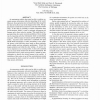Free Online Productivity Tools
i2Speak
i2Symbol
i2OCR
iTex2Img
iWeb2Print
iWeb2Shot
i2Type
iPdf2Split
iPdf2Merge
i2Bopomofo
i2Arabic
i2Style
i2Image
i2PDF
iLatex2Rtf
Sci2ools
MVA
1990
1990
Using and Generating Environment Models for Indoor Mobile Robots
An autonomous mobile robot must be able to combine uncertain sensory information with prior knowledge of the world. Moreover, these operations have to be performed fast enough for the robot to be able to react to the changes in the world. This paper presents a model-driven system for a real-time indoor mobile robot. As the robot is constantly in motion. information from an Environment Model is used to anticipate information-rich features and to direct selective sensing. This model-based expectation helps the system overcome problems of slow sensing rate by requesting only that information which is immediately necessary. Direrent types of features activate different sensing modes. Uncertain sensor information is combined with prior World Model knowledge to reduce uncertainty in the model. We present a hall-following robot, based on these principles, which exhibits real-time navigation performance. It does this despite primitive and relatively slow sensing. As such a system is dcpendcnt...
| Added | 07 Nov 2010 |
| Updated | 07 Nov 2010 |
| Type | Conference |
| Year | 1990 |
| Where | MVA |
| Authors | Yuval Roth-Tabak, Terry E. Weymouth |
Comments (0)

